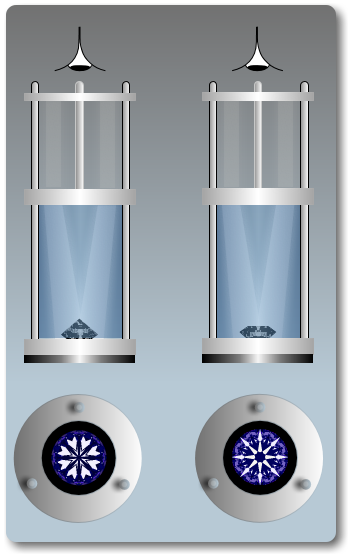
Hearts and Arrows
What is Hearts and Arrows?
 Hearts and Arrows diamonds (H&A) are
round brilliants with special patterns visible under specific lighting conditions.
They consist of eight hearts when viewed from the pavilion side and
eight arrows when viewed from the crown side.
Hearts and Arrows diamonds (H&A) are
round brilliants with special patterns visible under specific lighting conditions.
They consist of eight hearts when viewed from the pavilion side and
eight arrows when viewed from the crown side.
Kinsaku Yamashita designed in 1988 an appropriate viewer which creates the typical images illustrated in the picture on the left. The viewer has a lens to visualize the effect to the human viewer. Above the lens on a well specified distance there is a bright white ring which functions as a light source, simulating the position of a common direct top light (spotlight, sun, ...). Underneath the lens there is a colored plastic film to simulate indirect light sources (painted walls). Light leakage zones, which reflect neither white or colored light, appear dark. The diamond is positioned on a platform at the bottom of the viewer. To view the arrows the diamond is turned and placed in a conical blind hole in the platform.
The viewer is simple and cheap. The question is
"Can we use this viewer as a grading instrument?"
The answer is no. The viewer is purely for commercial environments to illustrate the effect to customers. The differences between viewers are considerable. The lack of any specification makes it possible to "customize" the viewing parameters. The original idea was to distinguish well performing diamonds from poor performing diamonds. If you adapt the conditions, less performing diamonds also exhibit the classical H&A patterns.
Cutting Hearts and Arrows is very difficult. The H&A pattern is very sensitive to symmetrical imperfections. Because of the high degree of symmetry and the limited proportion sets for which the patterns are visible a premium on the price for H&A brilliants is often applied. Because of this price difference some diamond dealers promote there diamonds as hearts and arrows. In most cases the patterns show serious defects due to misalignment or wrong proportions. Again the lack of standardization prohibits the distinction between irregular and "true" hearts and arrows.
To put an end on this discussions HRD Antwerp ordered a research project to solve several problems linked with grading the H&A pattern.